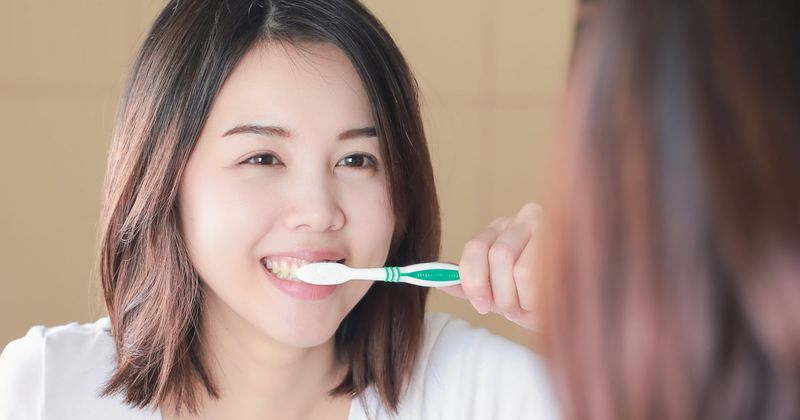Toothpaste provides oral mucosal immunotherapy for peanut allergy
Key takeaways:
- Patients brushed with the toothpaste once a day for 48 weeks.
- Results were consistent with immunological treatment.
- Side effects primarily included itching around the mouth and oral cavity.
WASHINGTON — Adults with peanut allergy safely used toothpaste infused with peanut protein as oral mucosal immunotherapy, according to a poster presented at the American Academy of Allergy, Asthma & Immunology Annual Meeting.
Participants demonstrated robust immunologic response as well, William E. Berger, MD, MBA, of Allergy & Asthma Solutions, told Healio.

“Food allergies affect over 200 million people around the world. The products that are on the market right now have not really met the need,” Berger said.

Current immunotherapies for food allergy include injections, swallowing and patches, he said, adding that only one has been approved by the FDA and the others are administered off-label.
“So, we were looking for an easy and convenient way for people to get treated,” he said.
Berger and his colleagues hypothesized that Langerhans cells throughout the oral cavity can activate immune responses, followed by allergen desensitization, as part of oral mucosa immunotherapy (OMIT).
Using proprietary technology, Intrommune Therapeutics can stabilize allergens and embed them into a fully functional toothpaste packaged with a metered dose dispenser. In this study, the company used peanuts in its INT301 toothpaste.
“But it can be used for other nuts or possibly even multiple nuts,” Berger said.
The phase 1 OMEGA study included 32 adults aged 18 to 55 years with a peanut allergy diagnosis confirmed by oral food challenges and testing of Ara h 1, 2, 3, 6, 8 and 9. The researchers also measured peanut-specific IgE and IgG4 serum levels.
Participants brushed their teeth with INT301 for 2 minutes once a day for 48 weeks.
“Because it’s such an easy thing to do and because it’s really incorporated into their daily routine, we had excellent adherence,” Berger said. “We had a 97% adherence rate, and we had no dropouts.”
Participants who failed double-blind placebo-controlled OFCs for 100 mg of peanut protein or less at baseline but tolerated 300 mg or more of peanut protein at the end of the study experienced statistically significant increases in IgG4 and decreases in IgE/IgG4 ratios, the researchers said.
“Our patients at the end were able to tolerate between 300 and 600 mg of peanuts,” Berger said.
Also, the researchers said that the laboratory values at the end of the study were consistent with immunological responses to treatment.
One female participant aged 21 years with a history of peanut allergies who failed an OFC with 12 mg of orally ingested peanut at baseline tolerated 600 mg of orally ingested peanut at the end of the study. Her IgG4 increased from 1.39 kU/L to 20.2 kU/L during the study, and her IgE/IgG ratio decreased from 71.9 to 5.
“The ratio went down, which you would expect,” Berger said.
This participant also experienced several mild, local adverse events including oral itching and tongue itching that the researchers said were likely related to the study drug. The other participants in the study also tolerated treatment well, with no significant systemic effects, Berger said.
“The only side effects of any significance were a little bit of itching around the mouth and the oral cavity,” he said.
However, the researchers cautioned that one participant who had failed the baseline OFC had results consistent with pollen food allergy syndrome, including Ara h 2 levels under 0.1, a negative skin prick test, specific IgE of 0.35 kU/L or less and positive Ara h 8 and 9.
These findings suggest that all food allergy treatments under development should consider possible difficulties in interpreting OFC results for patients with pollen food allergy syndrome.
“We were at an FDA meeting, and they said that in future peanut studies, they’re going to suggest that Ara 8 and Ara 9 be measured so that we don’t enter people into the study because they’re not peanut allergic or because they’re pollen allergic and it cross-reacts,” Berger said.
Considering these results, which indicate safe and effective treatment with OMIT with robust immunologic response, Berger said that he and his colleagues plan on continuing with a pediatric study of approximately 80 patients.
“We think we may even get better results because they have a stronger immunologic response to immunotherapy,” Berger said.
Berger anticipated high adherence among children since their caregivers already ensure they brush their teeth anyway. Plus, he noted that the toothpaste tastes better than other oral immunotherapies, which many patients complain about, especially children.
“We think we’ve overcome that,” he said.
Plus, Berger noted the toothpaste’s flexibility as a delivery system for immunotherapy.
“This study basically supports the platform of using oral mucosal immunotherapy, and it has potential for many other foods and possibly other allergies,” he said. “We’ve got a different entry point into the treatment of food allergies.”
Reference:
- Berger WE. J Allergy Clin Immunol. 2024;doi:10.1016/j.jaci.2023.11.870.
- OMEGA study: A study of the safety and feasibility of up-titration with INT301 in adults with sensitivity to peanut. https://clinicaltrials.gov/study/NCT04603300. Published July 28, 2023. Accessed March 6, 2024.

